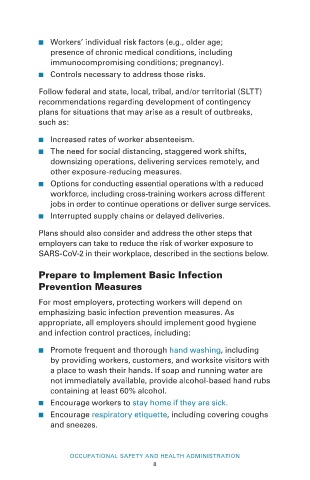Page 456 - Safety Memo
P. 456
■ Workers’ individual risk factors (e.g., older age;
presence of chronic medical conditions, including
immunocompromising conditions; pregnancy).
■ Controls necessary to address those risks.
Follow federal and state, local, tribal, and/or territorial (SLTT)
recommendations regarding development of contingency
plans for situations that may arise as a result of outbreaks,
such as:
■ Increased rates of worker absenteeism.
■ The need for social distancing, staggered work shifts,
downsizing operations, delivering services remotely, and
other exposure-reducing measures.
■ Options for conducting essential operations with a reduced
workforce, including cross-training workers across different
jobs in order to continue operations or deliver surge services.
■ Interrupted supply chains or delayed deliveries.
Plans should also consider and address the other steps that
employers can take to reduce the risk of worker exposure to
SARS-CoV-2 in their workplace, described in the sections below.
Prepare to Implement Basic Infection
Prevention Measures
For most employers, protecting workers will depend on
emphasizing basic infection prevention measures. As
appropriate, all employers should implement good hygiene
and infection control practices, including:
■ Promote frequent and thorough hand washing, including
by providing workers, customers, and worksite visitors with
a place to wash their hands. If soap and running water are
not immediately available, provide alcohol-based hand rubs
containing at least 60% alcohol.
■ Encourage workers to stay home if they are sick.
■ Encourage respiratory etiquette, including covering coughs
and sneezes.
OCCUPATIONAL SAFETY AND HEALTH ADMINISTRATION
8

